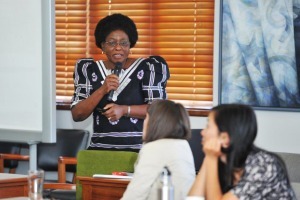HIV survey findings a mixed bag
24 April 2014 | Story by Newsroom
HIV prevalence among children and youths has dropped, while there has been an increase among adults in South Africa.
The good news, said Dr Olive Shisana, CEO of the Human Science Research Council (HSRC), is the increase among adults is because people with HIV are living longer due to antiretroviral therapy (ART).
"The significant drop in children aged 0-4 years is as a result of a reduction in mother-to-child transmission. Our policy of prioritising children is very good because it means that children are living much longer," she added.
Shisana recently presented the findings of the 2012 South African National HIV Prevalence, Incidence and Behaviour Survey at an interactive session about HIV, science and community engagement at UCT. The event was hosted by the International AIDS Society, the Desmond Tutu HIV Foundation, and the HIV/AIDS, Inclusivity and Change Unit (HAICU). Other speakers included Professor Linda-Gail Bekker, Deputy Director of The Desmond Tutu HIV Centre and Cal Volks, director of HAICU.
6.4 million South Africans living with HIV
Over 38 000 South Africans participated in the survey '“ the fourth of its kind '“ while just under 29 000 of these subjects agreed to be tested for HIV. The estimated overall prevalence of HIV increased from 10.6% in 2008 to 12.2% in 2012. This translates to 6.4 million living with HIV.
South Africans are increasingly engaging in risky sexual behaviour and participants reported an increase in multiple sexual partners. Another worrying trend pointed out by Shisana, the principal investigator in the study, is the decline in condom use in every age group '“ except those who are fifty years and older.
The study found that among high risk groups, knowledge of HIV transmission was poor. "Not only are the knowledge levels low, but they are declining," noted Shisana.
"We have an epidemic that continues to rage. We have all lowered our guard. The nation as a whole has become complacent. It is as if we're telling ourselves, 'we have ARVs now, we can treat ourselves out of this epidemic'," remarked Shisana.
Of particular concern to Shisana is the high HIV prevalence and incidence (new HIV infections in a given year) among young women. "Among women aged 30-34, HIV prevalence is at 35%. This is very high, extremely high '“ unacceptable for our country. To have 2.54% new infections occurring each year among young women aged 15-24 years is a crisis. We have to do something to address the problem," she urged.
Story by Abigail Calata. Image by Raymond Botha.
 This work is licensed under a Creative Commons Attribution-NoDerivatives 4.0 International License.
This work is licensed under a Creative Commons Attribution-NoDerivatives 4.0 International License.
Please view the republishing articles page for more information.










